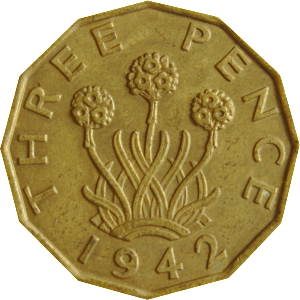British money before decimalisation
 In a strange British perverse way, those of us who remember the ‘old money’ took a secret delight in its complexity. Today, it’s easy. Like dollars and cents, there are one hundred pennies to the pound. Arithmetic is simple.
In a strange British perverse way, those of us who remember the ‘old money’ took a secret delight in its complexity. Today, it’s easy. Like dollars and cents, there are one hundred pennies to the pound. Arithmetic is simple.
Foreign visitors are no longer baffled.
The old system, which evolved relatively naturally sounds quite bonkers, but even the most innumerate people (such as me) who were brought up with it had no problem.
You see, in those days, we didn’t just have pounds and pennies, we had pounds, shillings and pence. Now, see if you can get your head around this delightful system.
- Each pound was made up of twenty shillings
- Each shilling was made up of twelve pence
So unlike today, each pound had 240 pennies. The mental arithmetic was such good exercise for the brain. As you can see in the image, you might have to add up how much money you needed if you wanted to buy three items thus:
- Item 1: £1/15/9 (one pound, fifteen shillings and ninepence)
- Item 2: 5/6 (five shillings and sixpence)
- Item 3: 19/11 (nineteen shillings and elevenpence)
Go on, give it a try! (answer below)
And just to confound foreigners even more, We had the following coins and notes:
- A farthing – one quarter of a penny
- A halfpenny (pronounced hayp-ny)
- A penny
- A threepenny piece (known as the threp-ny bit)
- A sixpence (often known as a tanner)
- A shilling (also known as a bob)
- A two shilling piece (called a florin)
- A two and sixpenny piece (called half a crown)
- A ten shilling note (ten bob)
- A pound note (a quid)
 Of course, the denominations were shown on the coins but not their names. So a foreign visitor might hear ‘those are a tanner apiece but I can let you have three for a bob’. To which the reply might be ‘have you got change for a half crown?’
Of course, the denominations were shown on the coins but not their names. So a foreign visitor might hear ‘those are a tanner apiece but I can let you have three for a bob’. To which the reply might be ‘have you got change for a half crown?’
Hehe
At the posh end, we had guineas. If you were buying groceries or day-to-day items you might never come across guineas but if you were buying something like a gentleman’s suit, you might see that the price was eight guineas. A guinea was one pound and one shilling, making eight guineas eight pounds and eight shillings. And of course, they’d be mixed so your suit would be eight guineas, the shirt £1/10/6 and the tie 11/9. (You’d get nine bob and ninepence change from eleven quid).
Answer to the sum above
The answer is £3/1/2 – three pounds, one shilling and two pence. Or, in the vernacular’ three quid, a bob and tuppence’. So if you paid for your purchases with three pound notes and a half-crown, how much change would you expect? You can see how it kept us on our toes! But even young kids could handle it just fine.
Remember that we didn’t have calculators!
ABOUT THE AUTHOR



